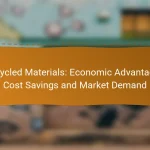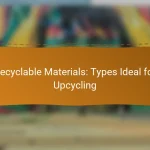Upcycling and recycling are two distinct approaches to waste management, each with unique processes and benefits. While upcycling creatively transforms waste into new products of higher value, recycling involves breaking down materials to produce new raw materials for manufacturing. Understanding these differences can help individuals make more informed choices about sustainability and resource conservation.
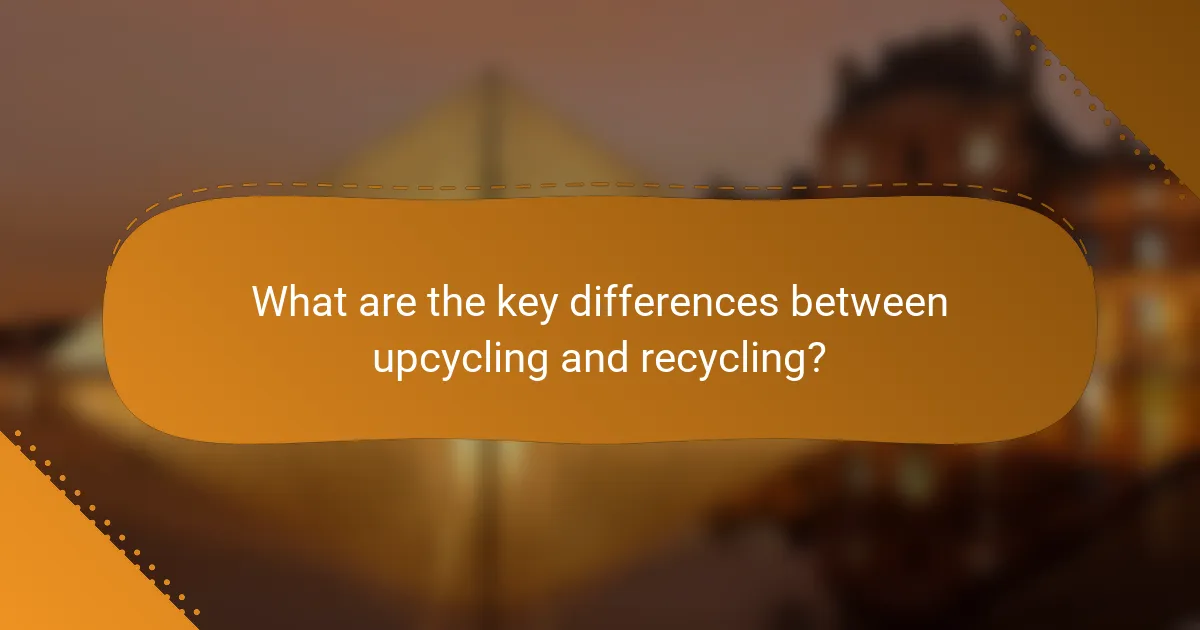
What are the key differences between upcycling and recycling?
Upcycling and recycling are two methods of waste management that differ in their processes and outcomes. Upcycling transforms waste into new products with higher value, while recycling breaks down materials to create new raw materials for manufacturing.
Upcycling creates new products from waste
Upcycling involves taking discarded items and creatively repurposing them into new products. This process often enhances the original item’s value and can result in unique, one-of-a-kind creations. For example, turning old wooden pallets into furniture or using glass jars as decorative storage containers are common upcycling practices.
One of the main advantages of upcycling is that it reduces waste while encouraging creativity and innovation. Individuals can engage in upcycling as a hobby or as a small business venture, often requiring minimal investment in tools or materials.
Recycling processes materials to create new raw materials
Recycling is a systematic process that involves collecting, sorting, and processing materials to produce new raw materials. Commonly recycled items include paper, plastics, and metals, which are broken down and reconstituted for use in manufacturing. For instance, recycled paper can be turned into new paper products, while aluminum cans can be melted down and reshaped.
Recycling typically requires more infrastructure and energy compared to upcycling, as it involves industrial processes. However, it plays a crucial role in reducing the demand for virgin materials and minimizing landfill waste.
Environmental impact varies between methods
The environmental impact of upcycling and recycling can differ significantly. Upcycling often has a lower carbon footprint since it usually requires less energy and fewer resources than recycling. By creatively reusing items, upcycling can help conserve natural resources and reduce pollution.
On the other hand, recycling, while energy-intensive, contributes to a circular economy by ensuring that materials are reused and not discarded. Both methods are essential for sustainable waste management, and choosing between them can depend on the specific materials involved and the desired outcomes.
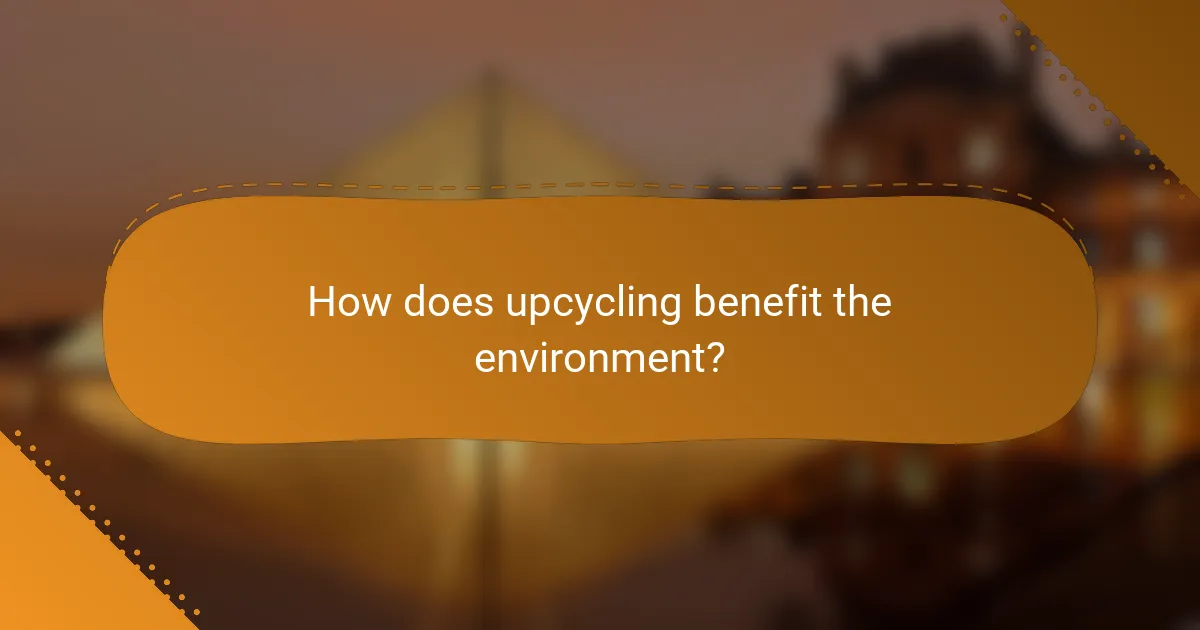
How does upcycling benefit the environment?
Upcycling benefits the environment by creatively repurposing materials, reducing the need for new resources and minimizing waste. This process not only diverts items from landfills but also encourages sustainable practices that can lead to a lower carbon footprint.
Reduces waste in landfills
Upcycling significantly reduces the amount of waste sent to landfills by transforming discarded items into new products. For example, turning old glass jars into decorative storage containers keeps them out of the waste stream and extends their life cycle.
By engaging in upcycling, individuals and businesses can contribute to a circular economy, where materials are reused rather than disposed of. This practice can help communities achieve waste reduction goals and comply with local regulations aimed at minimizing landfill use.
Conserves natural resources
Upcycling conserves natural resources by decreasing the demand for raw materials needed to create new products. For instance, using reclaimed wood from old furniture to build new items reduces the need for logging and the associated environmental impact.
Additionally, upcycling often requires less energy than recycling processes, which can be resource-intensive. By choosing to upcycle, consumers can play a role in preserving ecosystems and reducing the depletion of finite resources.
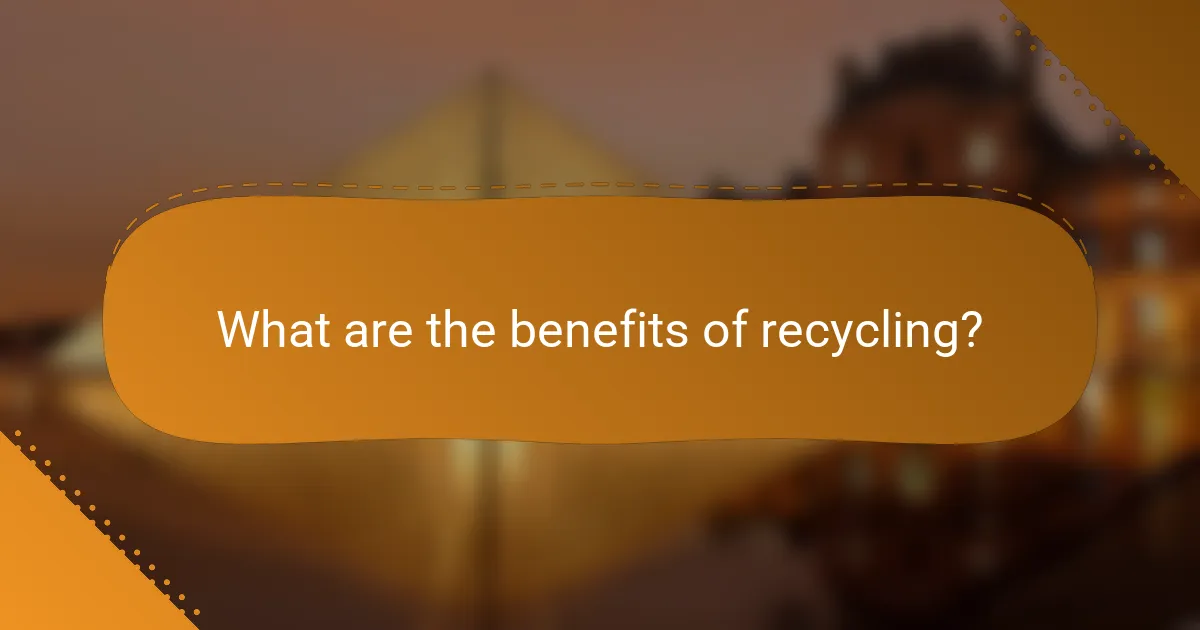
What are the benefits of recycling?
Recycling offers numerous benefits, including conserving natural resources and reducing waste in landfills. By processing materials like paper, glass, and metals, recycling minimizes the need for new raw materials and supports a more sustainable environment.
Reduces energy consumption
Recycling significantly lowers energy usage compared to producing new products from raw materials. For instance, recycling aluminum saves about 90% of the energy required to create new aluminum from bauxite ore. This reduction in energy consumption contributes to decreased fossil fuel use and lower greenhouse gas emissions.
To maximize energy savings, focus on recycling materials that require high energy input for production, such as metals and plastics. Implementing local recycling programs can help communities achieve these energy efficiencies effectively.
Decreases pollution levels
Recycling helps reduce pollution by minimizing the emissions generated during the manufacturing process. When materials are recycled, fewer pollutants are released into the air and water compared to producing new items from virgin materials. This is particularly true for hazardous materials like plastics and metals.
Communities can further decrease pollution by promoting recycling initiatives and educating residents about proper disposal methods. Engaging in local recycling efforts can lead to cleaner neighborhoods and a healthier environment for all residents.

What materials can be upcycled?
Upcycling involves transforming waste materials into new products of higher value or quality. Common materials suitable for upcycling include furniture, clothing, and various containers, allowing for creativity and sustainability.
Furniture and home decor
Furniture and home decor items are prime candidates for upcycling. Old wooden furniture can be sanded down and refinished, while outdated pieces can be painted or reupholstered to fit modern aesthetics. Consider using materials like pallets or crates to create unique shelving or tables.
When upcycling furniture, ensure the structural integrity is intact. Check for any damage that may require repair before starting your project. This not only ensures safety but also enhances the final product’s durability.
Clothing and textiles
Clothing and textiles are versatile materials for upcycling. Old garments can be transformed into new fashion items, such as turning jeans into bags or t-shirts into quilts. This process not only reduces waste but also allows for personal expression through unique designs.
Before upcycling textiles, assess the fabric’s condition. If the material is stained or heavily worn, it may not be suitable for certain projects. Simple sewing skills can go a long way in creating stylish new pieces from old items.
Plastic and glass containers
Plastic and glass containers can be creatively upcycled into functional items. Glass jars can serve as storage solutions or decorative vases, while plastic bottles can be transformed into planters or organizers. These projects often require minimal tools and can be completed quickly.
When upcycling containers, clean them thoroughly to remove any residues. Additionally, consider the environmental impact of the materials you choose; opting for reusable items helps reduce overall waste and promotes sustainability.

What materials can be recycled?
Recyclable materials include a variety of items that can be processed and transformed into new products. Commonly accepted materials vary by location, but generally encompass paper, metals, glass, and certain plastics.
Paper and cardboard
Paper and cardboard are among the most widely recycled materials. Items like newspapers, office paper, and cardboard boxes can typically be placed in recycling bins, but they should be clean and dry to avoid contamination.
Check local guidelines, as some areas may not accept certain types of paper, such as coated or glossy materials. It’s advisable to flatten cardboard boxes to save space in recycling containers.
Metals and aluminum
Metals, including aluminum cans and steel products, are highly recyclable and can be processed indefinitely without losing quality. Common items like beverage cans, food tins, and scrap metal are often accepted in recycling programs.
Rinse out containers to prevent food residue from contaminating the recycling stream. Many recycling centers offer cash incentives for returning aluminum cans, making it a financially rewarding practice.
Glass and certain plastics
Glass bottles and jars are fully recyclable and can be reused multiple times without degradation. Most recycling programs accept clear, green, and brown glass, but check for local restrictions on colored glass.
Plastics can be more complex; only certain types, usually labeled with recycling codes 1 (PETE) and 2 (HDPE), are commonly accepted. Always clean and sort plastics according to local recycling rules to ensure they are processed correctly.

How can I start upcycling at home?
Starting upcycling at home involves creatively transforming unwanted items into new, useful products. This process not only reduces waste but also allows you to personalize your living space with unique creations.
Identify items to repurpose
Begin by surveying your home for items that are no longer in use, such as old furniture, glass jars, or worn-out clothing. Common candidates for upcycling include wooden pallets, tin cans, and plastic bottles.
Consider the potential of each item. For example, an old ladder can become a bookshelf, while glass jars can be turned into decorative storage containers. Look for items that can serve a new purpose with minimal modifications.
Gather necessary tools and materials
Once you’ve identified items to upcycle, gather the tools and materials you’ll need for your projects. Basic tools may include scissors, a hammer, paint, and glue, depending on the items you plan to work with.
Additionally, consider sourcing extra materials like fabric scraps, paint, or decorative elements from local thrift stores or craft shops. Having a well-stocked toolkit will make your upcycling efforts smoother and more enjoyable.

